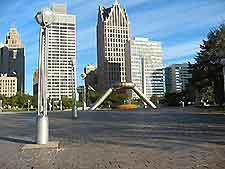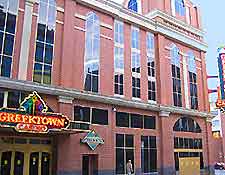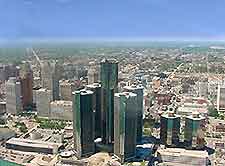Detroit Neighborhoods, Locations and Districts
(Detroit, Michigan - MI, USA)

Known as the Motor City due to the prolific automobile industry that was created by Henry Ford and his assembly line production methods, Detroit has far more to offer than just cars. After struggling through a lengthy economic slump the entire city of Detroit has seen a revival in recent years, with pockets of chic, upscale urban areas and districts emerging and many old buildings being revamped.
The Motor City is currently home to an eclectic mix of ethnic, arty, historical and fashionable districts, and Detroit now offers visitors a wealth of entertainment and education options with a sharp focus on live music, cultural attractions and culinary creations.
Bricktown
Sandwiched between Greektown and the Renaissance Center, the area known as Bricktown is a tiny community of 19th and 20th century brick industrial buildings and warehouses that, like other parts of Detroit, are undergoing a metamorphosis from tattered to trendy. Copious renovations and the development of elegant loft apartments, Bohemian boutiques, trendy restaurants, live music nightspots and the Greektown casino have imbued the neighborhood with a contemporary, industrial-chic air. Two historical buildings in particular, Detroit's oldest standing church and the Italian Renaissance Wayne County Building, provide an extra touch of interest.
Cultural Center Historic District
The flavor of this neighborhood is summed up in its name - this is Detroit's cultural hub, complete with historical architectural structures, museums and galleries galore. The Cultural Center Historic District, located north of downtown between the Theater District and New Center area, is home to the Detroit Public Library, the Detroit Institute of Arts (DIA) and the Horace H. Rackham Education Memorial Building, all striking examples of early to mid-20th century architecture. Each building has its own distinctive style and character, with the Detroit Public Library boasting a marble Italian Renaissance front, while the DIA is a Beaux Arts design and the Rackham building an imposing limestone construction. The DIA's interior is more impressive than its exterior, with a vast collection of artistic masterpieces. Also located in Detroit's Cultural Center Historic District are the Detroit Historical Museum, International Institute, Society of Arts and Crafts Art School, Detroit Science Center, Charles H. Wright Museum of African American History and Orchestra Hall, all offering exposure to multiple facets of Detroit's history and culture in one small area.
Eastern Market
The Eastern Market district, on the outskirts of downtown Detroit, was founded in 1841 and continued to flourish through the latter half of the century when a number of dining establishments began to creep in between the sale sheds. Despite the bombardment of pre-packaged foods that accompanied the post-WWII era, Detroit's Eastern Market district retained its traditional role as a fresh produce retailer and gastronomic delight and went on to be declared a historic site in 1977.

Greektown
The ethnic neighborhood of Greektown is bursting with atmosphere and saturated with excellent Mediterranean meze spots, elegant eateries, lively coffeehouses and fragrant bakeries, making it one of Detroit's most alluring culinary destinations and the site of some of the city's most talked about restaurants. In addition, Detroit's Greektown district is packed with late night venues offering a riot of irresistible evening entertainment and including the delightful Greektown casino. Greektown's status as a leading ethnic retailing district has been set in stone for over a century and the neighborhood's Trapper's Alley is still a favorite with beady eyed shoppers.
Hamtrack
Another exciting district for night owls, Hamtrack is crammed full of vibrant live music venues and is a great place to go to listen or be heard. Founded as a township in 1798, Hamtrack slowly evolved to become a village and then later it developed into a farming community before it witnessed a population explosion rooted in the firing automobile industry that propelled its status to that of an urban center. Today it is still characterized by its historically prominent Polish culture and visitors can enjoy perusing the Polish bakeries and specialty shops that are a regular feature of its streets.

New Center
As Woodward Boulevard took on the appearance of a main street, the residents of the area that is now known as the New Center district became concerned that the district might be overtaken by an unattractive urban slide. As a response to these concerns, Detroit's Virginia Park Improvement Association was created and landed with the task of maintaining the area's aesthetic integrity. The Fischer Family, along with the esteemed architect Albert Kahn, redesigned the area to become a 'second downtown'. Now the New Center district sprawls across an extensive section of Detroit encompassing the GM headquarters 'Cadillac Place' and the Fischer Building.
Rivertown / Civic Center
While much of downtown Detroit is decrepit, vacant and spooky, the eastern area along the riverfront, known as Rivertown or the Civic Center, is a breath of fresh air amid the dust. Vibrant and pretty, this section of the city saw a revival in the 1950s after mass movement to the suburbs prompted the necessity to attract focus back to downtown. Several new entertainment and civic structures were created, including the Veteran's Memorial Building, City-County Building, Ford Auditorium, Albert East Cobo Hall and Arena and Hart Plaza, which presently hosts scores of ethnic and musical festivals throughout the summer. The most prestigious events held at Detroit's Hart Plaza are the Ford Detroit International Jazz Festival, the most sizeable of its kind in the world, and the Detroit Electronic Music Festival, the largest free music festival in the world.
Theater District
Another culture rich Detroit district, Theater District is second only to Broadway in providing the world's greatest number of theater seats and is home to some of the city's most beautiful refurbished buildings. Among these are the Fox Theater, which features on Michigan's National Historic Landmarks list; the Detroit Opera House, formally known as the Capitol Theater; Gem Theater; Century Club; State Theater; and the Second City Comedy Theater, all of which still actively supply entertainment to Detroit's residents and visitors.
 Known as the Motor City due to the prolific automobile industry that was created by Henry Ford and his assembly line production methods, Detroit has far more to offer than just cars. After struggling through a lengthy economic slump the entire city of Detroit has seen a revival in recent years, with pockets of chic, upscale urban areas and districts emerging and many old buildings being revamped.
Known as the Motor City due to the prolific automobile industry that was created by Henry Ford and his assembly line production methods, Detroit has far more to offer than just cars. After struggling through a lengthy economic slump the entire city of Detroit has seen a revival in recent years, with pockets of chic, upscale urban areas and districts emerging and many old buildings being revamped.
